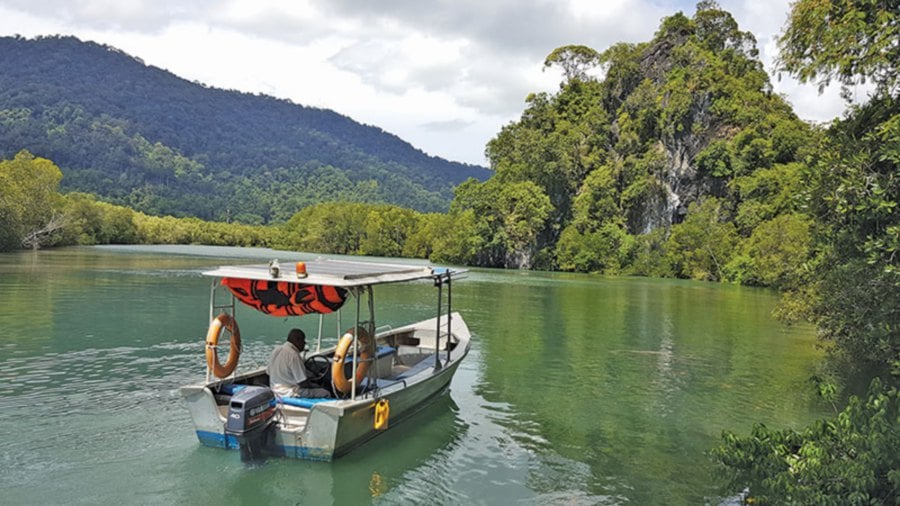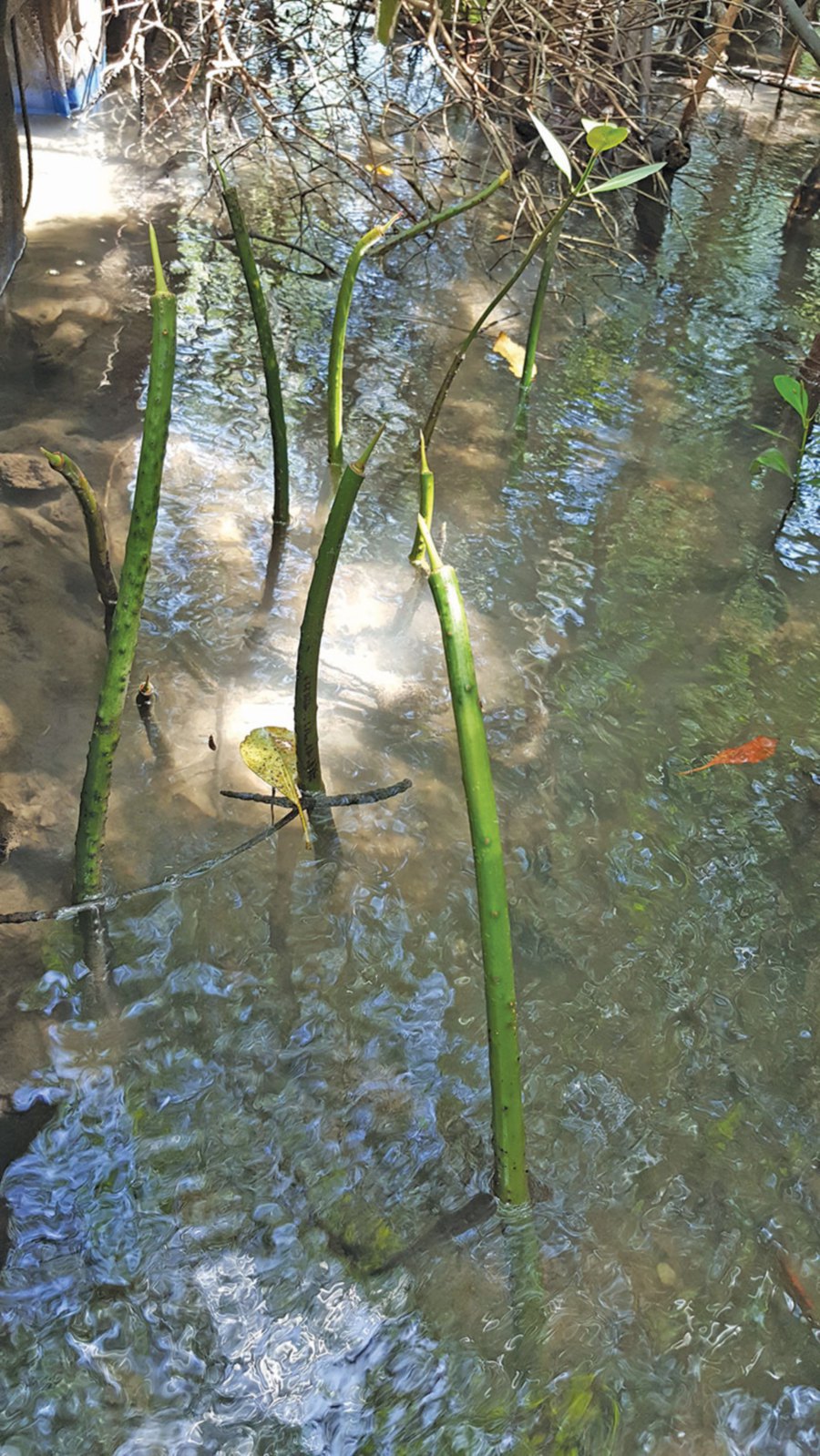Mangrove magic
Published on May 14, 2017 | by nst.com.my


“OUCH!” The sun’s scorching rays sear my back, penetrating through the flimsy layer of my white cotton top.
I could’ve sworn that if I were to remain a nanosecond further in my lofty “post” on the bow of the boat, my hair too would fry under the rays.
Silently cursing myself for having forgotten to bring my sunnies and straw hat in my haste to leave the cool comfort of my plush abode at St Regis, Langkawi, to join this tour, I slide off my perch and wobble my way towards the stern, where driver Pak Nayan is calmly steering us down the meandering Sg Kubang Badak.

Plonking myself on the bench in front of him, sufficiently shaded, I can now focus on the captivating vista around me.
“Yes, you might need to move around in the boat throughout this trip to find some shade,” says Fendi, the resident naturalist and my tour guide on this mangrove excursion, organised by the hotel and JungleWalla Tours, chuckling as he notes my pathetic attempts to play hide-and-seek with Mr Sun.
“Don’t worry, you’ll soon forget about the heat. There’s a lot to see and learn here in the Kubang Badak mangrove forest reserve.”
And he’s right. Set against the backdrop of a sapphire blue canvas are the dramatic limestone karst hill forests juxtaposed against the freshwater Melaleuca woodlands and mangrove forest communities, the most diverse I have ever seen in all my mangrove sojourns around the country.
The only sound to penetrate the tranquillity of our magical surrounds is the muffled droning of the boat’s engine and Fendi’s voice as he softly regales me with some fascinating trivia about the area that we’re exploring.
Kubang Badak, one of the gazetted Unesco Geopark areas dominated by the low-lying estuary of the Sg Kubang Badak, is located in the north-west coast of Langkawi island, just to the north of Langkawi International Airport.
The name Kubang Badak, begins the Perlis-born guide, whose passion also includes birdwatching and studying spiders, was given to the area as it was believed to have had rhinos or badak roaming here at one time.
“At least that’s what the villagers tell me. But of course, now there’s no more to be seen,” he adds.
When it comes to mangrove tours, the Kilim Geoforest Park has a higher profile compared to the one I’m on today.
But Fendi is adamant that nothing compares to the Kubang Badak trail when it comes to the diversity of mangrove species.
Reeling off some maths, Fendi points out: “In the world, there are over 120 species of mangroves, of which 69 are considered ‘mangrove exclusive’. Malaysia has 48 mangrove exclusive species, and Langkawi has 32 of these (exclusive) species. Meanwhile, Kubang Badak has over 20 exclusive species. That’s impressive.”
INSIGHT INTO MANGROVE WORLD
Never good at maths anyway, my bewildered expression soon catches the 27-year-old’s attention and he patiently proceeds to explain that “mangrove exclusive” species are those that occur in exclusively mangrove environment.
Mangrove plants, he adds, are grouped into three types — mangrove exclusive (also known as true mangroves), mangrove non-exclusive and mangrove associates. The one that he’s referring to, the “exclusive”, are mainly restricted to intertidal zone between high water levels of neap and spring tides.
Meanwhile, the plants are morphological adapted to survive in extreme coastal weather conditions.
“Just note their aerial roots, the leathery leaves and the way that the seeds can germinate while still attached to the parent plant.”
Suddenly pointing to what appears like a flowering shrub ahead of us, Fendi hollers to Pak Nayan to change course slightly and head towards the left.
As the boat glides smoothly to the target and comes to a wobbly stop, Fendi reaches over the side and plucks some samples to show me.

“Flowers!” I exclaim. His head bobs enthusiastically. “Yup, mangroves do have flowers — and fruits. The flowers may not look as pretty as those you get outside but insects are attracted to them and up to 60 per cent of butterflies prefer to live in the mangroves.”
According to mangrovewatch.org, mangrove flowers are spectacularly variable in structure with perfect combined-sex flowers (like Rhizophora spp., Sonneratia spp., Avicennia spp.), separate-sex flowers (like Heritiera littoralis), and separate-sex trees (such as Excoecaria agallocha).
Contrary to my perception, the flowers come in different colours, ranging from white, red, pink, purple, lilac, pale yellow and orange yellow.
WHERE EVERYTHING FALLS INTO PLACE
As the boat continues to chug regally along the river, the waters glistening magically under the afternoon sun, and me having finally made peace with Mr Sun and duly returned to my lofty perch on the boat’s bow, I can’t help but sigh in contentment at God’s handiwork.
Suddenly, the speed drops and the boat circles an area where a single tree appears to hold court surrounded by smaller plants in the water, as if genuflecting to a mother plant.
“That’s a pioneer species, the one that’s responsible for setting up this mangrove forest,” explains Fendi, of the scene in front of us.
In sonneratia and avicennia species, the roots are different, he adds. The pneumatophores or erect roots are erect side branches of the horizontal roots, which grow just below the soil.

In the latter, they look pencil-like while the former grow slowly to become woody. The widely spreading horizontal roots, from which the pneumatophores grow, help to anchor the species in the unstable mud.
“In low tide, you’ll be able to see lots of spiky things sticking up from the water,” says Fendi.
The roots, he adds, would grow in such a way that they seem to be telling the other species not to grow around them.
“See the tree there? It’s a sonneratia alba and not much grows around it. But as it gets older and bigger, you’ll see other species growing around it. From sonneratia and avicennia, normally you’ll see rhizophora together with brugueira (bakau putih) and ceriops tagal (tengar putih) around it. But it normally takes a long time for species like rhizophora, brugueira and ceriops tagal to grow around it.”
The most dominant group of mangrove tree species at Kubang Badak is in the family Rhizophoraeae — with Rhizophora apiculata, or Bakau Minyak in Malay, being the most dominant species throughout the system.
According to WWF, this isn’t really surprising as historically, the Kubang Badak Forest Reserve was a production forest, which means that the trees were grown specifically for the purposes of forestry use (at Kubang Badak Forest Reserve logs were cut primarily for charcoal production).
SURVIVAL AND ADAPTION
Soon, the boat glides to a halt in front of what appears to be a small, wooden make-shift walkway.
“Let’s walk in the mangroves,” Fendi coaxes, his voice excited, before informing me that the trail was built by Lada (Langkawi Development Authority) to enable visitors to get up close with the mangroves.
It’s certainly surreal inside the mangrove world. Just a sliver of sunlight filters through from above, casting little stars on the still waters. Gnarled roots that appear like wizened hands make me think of scenes from The Lord of the Rings. Somehow. And there’s a slight smell in the air but not unpleasant. “Decomposed mangrove fruit maybe,” offers Fendi.

People need to understand the importance of mangrove forests, says Fendi, brows furrowing as we walk together along the narrow wooden trail, getting deeper into the inner sanctum of this mangrove wonderland.
“They protect coastlines against wind and wave actions and they’re the best natural barriers against tsunamis and storms. They provide resources for coastal communities and can be harvested sustainably for not only wood but other products too,” Fendi reels off.
A huge percentage of fish landings on the west coast of Peninsular Malaysia are connected to mangroves, he adds.
“Mangroves are an important breeding ground for fishes, prawns and many other marine animals.”
According to WWF, Malaysia’s mangroves are more diverse than those in tropical Australia, the Red Sea, tropical Africa and the Americas.
As I try to digest the weight of what Fendi’s been trying to tell me all morning, I realise how shallow my knowledge is of these botanical amphibians that straddle land and sea, and support such a wealth of life. And yet they’re one of the world’s most threatened tropical ecosystems, thanks to unscrupulous clearing and overharvesting, among others. The health of our planet lies in their gnarled and wizened hands. So why are we destroying them?
Saving them
Conservation of mangroves can be enhanced by:
• Gazetting all remaining mangrove forests within forest reserves or protected areas. Some mangrove forests are already gazetted such as the Matang Forest Reserve in Perak, the Kuala Selangor Nature Park in Selangor, the Bako National Park in Sarawak, the Kota Kinabalu City Bird Sanctuary and Sepilok Forest Reserve in Sabah. But there’s still some areas that remain unprotected.
• Devising well-balanced coastal land-use plans, which includes maintaining sustainable limits in logging and other harvesting activities of its resources.
• Retaining protective mangrove buffers†along coastlines and rivers to prevent erosion.
• Managing mangrove forests as fishery reserves to encourage environmentally-sensitive commercial aquaculture activities.
• Raising public awareness and educating the community to discourage indiscriminate clearing.
• Introducing social forestry schemes. Damaged forest areas can be planted and managed for small-scale village timber enterprises. Mangrove species like Rhizophora mucronata or R. apiculata are ideal for mangrove plantations as they’re fast growing and lucrative.
(SOURCE: WWF-Malaysia)








